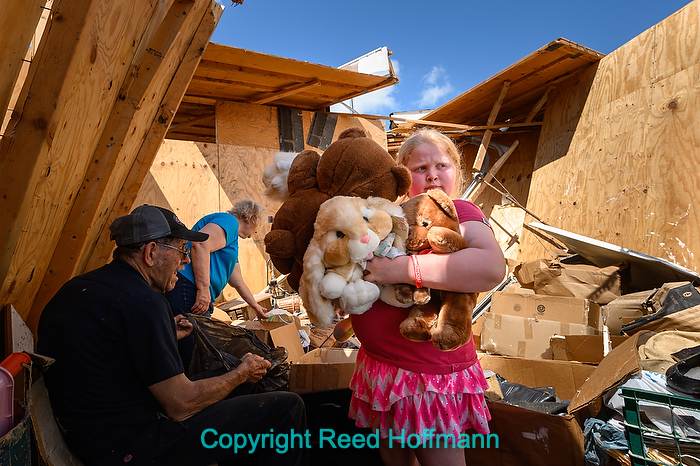Late last Wednesday night, May 22, a tornado tore through parts of Jefferson City, MO. The next morning at 8:30 my phone rang, “Are you available for a news job today?” That’s how I ended up photographing the destruction that tornado left in its wake.
When I moved to Kansas City in 2000, I left a career as a newspaper photographer where I’d worked at papers in the Midwest, South and East since the mid-1970s. Starting a freelance business here, most of my work was for newspapers, magazines and wire services. In time, teaching became my core business, but I still do occasional editorial (news and sports) work, which is why Getty Images called me Thursday morning.
In thirty minutes, I had packed two cameras, four lenses, a strobe, spare cards and batteries, laptop and card reader, rain gear and an overnight bag (just in case). Plus food and water. And, despite being summer and quite humid, I was dressed in tan slacks and a blue dress shirt. If I was walking into a news scene, I knew I’d be better received by the people there if I looked professional. By 11:30am, I was arriving at the first location that had been emailed to me. Nothing there, so I headed to the second. There I found a police roadblock. After identifying myself as a photographer working for Getty Images, I was directed to media parking and started working.
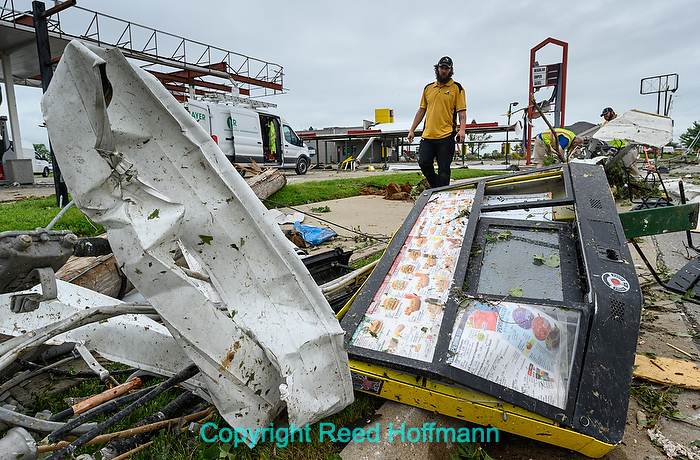
This was among the first photos I took, trying to show some of the devastation along Ellis Boulevard. You’ll see that in all the photos in this post, I used a wide-angle lens to feature a prominent foreground subject/object while also showing the amount of destruction around it. Nikon Z7, ISO 250, f/8 at 1/1000, Nikkor 18-35mm lens at 21mm.
News photography is like any other as far as exposure and composition, but you need to work fast. It’s also important to include the human element, because in this case the story isn’t just the destruction, but the impact it has on people’s lives. I was told to find about ten strong pictures quickly, then get to someplace I could download, edit, caption and transmit. As I walked the area, I took pictures of piles of debris, downed power lines and smashed trees. What I needed, though, was people, and I found the first of those at a church.
When people ask me what it takes to be a good news photographer, they’re often surprised when the first thing I say is “good people skills.” While I may have the right at a news scene to photograph anything that’s happening without asking, that’s not how I prefer to work. I’d rather walk up to the person involved, introduce myself and explain what I’m doing, then ask permission to take photos. Being sincere, and sympathetic to what the person is going through, is important. I’m trying to create a rapport with them, so they’ll feel more comfortable with me there. Plus, it’s important to identify any people in the photo, their names, why they’re there, what has happened to them. They’re more likely to give me that information after they’ve agreed to be photographed. And, they may have important information to share with me. That’s what happened at the church.
I asked a man outside if he was a member, which he was, and if he knew anything about the extent of the damage. He pointed out the pastor and chairman of the board, who were being interviewed by a TV crew, so I continued talking with him. During that, he asked if I’d been to the auto dealership down the road, which he’d heard was much worse than where we were. Guess where I was headed next?
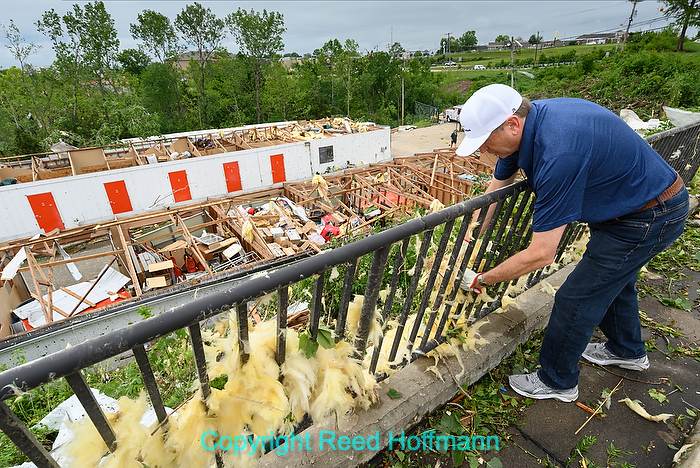
This man picking fiberglass insulation out of a fence turned out to be Kit Stolen, the CEO of Providence Bank, cleaning up behind his damaged branch bank, Nikon Z7, ISO 250, f/8 at 1/500, Nikkor 18-35mm at 18mm.
On the way there I passed a bank and noticed someone behind it cleaning up debris. Walking up, I asked if he’d mind if I took pictures. He said that was fine. When finished, I asked his name, and if he worked there. Turns out he was the CEO of the bank, which of course was important information for the photo.
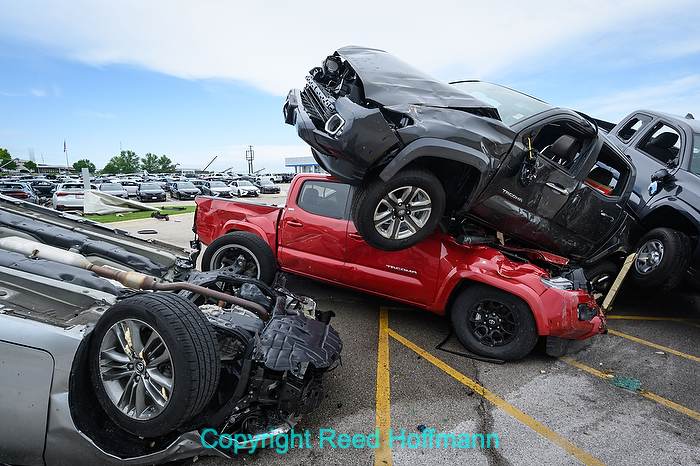
Some of the destruction at Riley Auto Group. Nikon Z7, ISO 250, f/10 at 1/250, Nikkor 18-35mm lens at 18mm.
The dealership was about a quarter-mile away, and when I got there, the damage was extensive – cars and trucks piled on top of each other. But there was also “do not cross” tape cordoning off the area. Putting my cameras down, I walked in and asked some of the folks nearby if there was someone in charge I could speak to. Next I was introducing myself to one of the owners and asking permission to take photos. He said sure, as long as I stayed out of the buildings. With his blessing, I now had free range of the property. After about thirty minutes there, I knew I needed to get back to my car and find a place to send photos. Walking back, I passed a bowling alley that was badly damaged with people going in and out. I knew I’d have a better chance of getting photos of damage inside a building if it was smaller and private, so I stopped and asked. “Sure, but we’re not responsible if you get hurt.” Great, five minutes later I had the photo I needed, of a customer who bowls there, heard about the damage and stopped by to help. A good story.
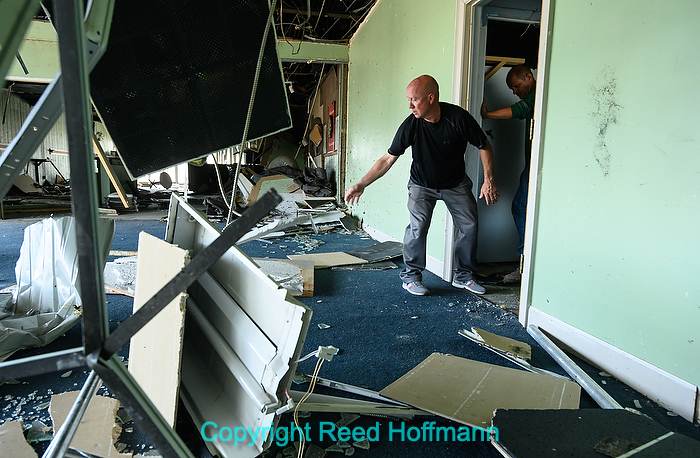
Chuck Clutts, Jr., heard about the tornado damage at a bowling alley where he’s a regular customer, and came by to help. Nikon Z7, ISO 1600, f/4.5 at 1/160. Nikkor 18-35mm lens at 23mm.
By the time I got back to my car, I’d been on the scene for two hours and now needed to find a place with WiFi so I could send photos. McDonalds may not be my favorite place to eat, but they all have WiFi. And, of course, I could get a fast bite of food and drink, plus use the bathroom. Better yet, on the way to the nearest McDonalds, I passed a larger, more impressive area of devastation than where I’d been. That’s where I’d head once my pictures were transmitted.

This is a small part of what I saw from the highway. Returning later, I found Dee Raithel sorting through the the remains of a storage unit looking for her possessions after a tornado leveled the area late Wednesday night. Nikon Z7, ISO 200, f/8 at 1/500, Nikkor 18-35mm lens at 18mm.
When people ask me about working for wire services covering things like pro sports, I tell them the photography’s not the hard part, it’s the work afterwards. Yes, you need to be able to make strong photos that stand out, but that does no good if you can’t properly caption and transmit them quickly. There’s a LOT of information that needs to go with a photo. That’s all kept in IPTC fields and often referred to as metadata. The Getty editor emailed me a template I could save and then load into my pictures in Photo Mechanic. Fortunately, 16 of the 18 fields could remain unchanged for all of my images. I’d just need to focus primarily on the caption – who, what, when, where and why are good places to start, and no more than two sentences. Like I said, a lot to do, and not much time to do it.
After less than an hour at McDonalds, I’d downloaded 245 RAW images from my Nikon Z7 and Z6 cameras, opened, edited, captioned and sent nine of them, confirmed with the editor in New York that everything looked good and was back on the road.
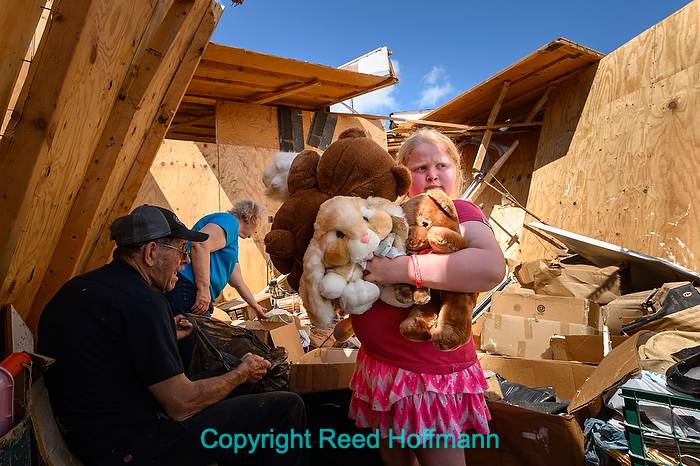
Nine-year-old Keeley Frank holds stuffed animals her grandparents salvaged from their storage unit. Nikon Z7, ISO 320, f/8 at 1/400, Nikkor 18-35mm lens at 18mm.
That scene of devastation I’d seen on the way to McDonalds turned out to be a large area of storage units and an auto repair business. From the highway it looked like acres and acres of 2X4s. Parking on a nearby road and walking in, I found a couple headed in and started chatting with them. They wanted to check on a boat he’d just spent three months rebuilding and had recently stored there. I asked if I could tag along and they said sure. For the next 90 minutes I worked that area. There was an old couple who had stored several family’s worth of treasures. Another family whose entire household was in there while they were building a new home. And even a man who had an old fire truck and ambulance stored, all in buildings that no longer existed. Despite the losses, people were mostly upbeat and just glad that they and their family were okay.
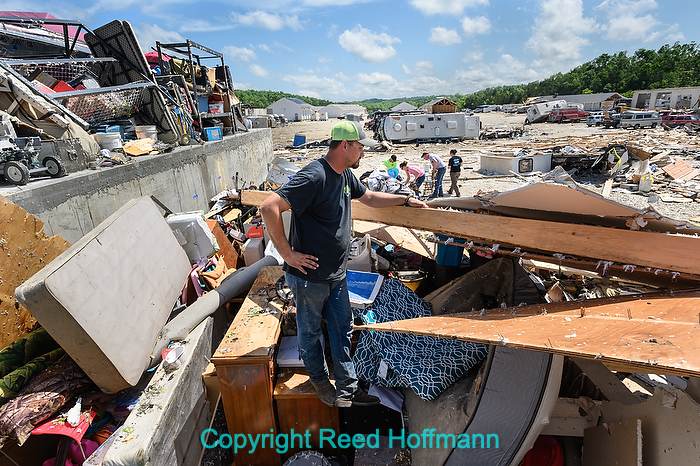
“We had everything in here but our clothes,” Dakota Libbert said. They had sold their home and were storing all their belongings here while building a new home when the tornado hit late Wednesday night. Nikon Z7, ISO 250, f/9 at 1/500, Nikkor 18-35mm lens at 18mm.
300 frames later, I was off to yet another McDonalds. This set of photos was even stronger, with more destruction and more personal stories from the people involved. I sent sixteen of them, checked in with the editor again and then got in my car for the drive home. I’d left at 9:00 that morning and was back home by 8:30 that night.
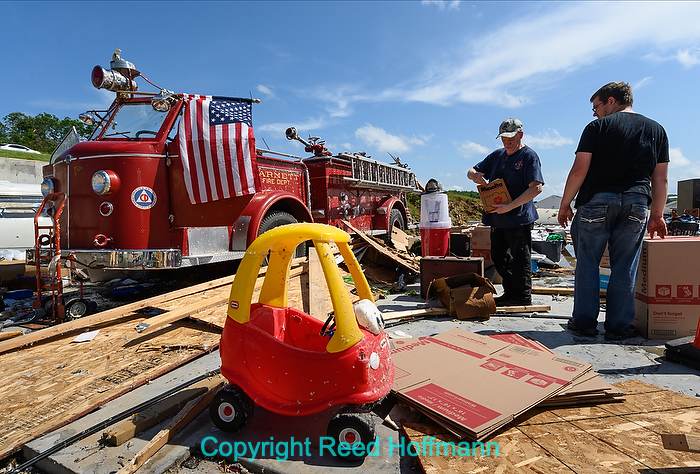
Bill Wirtel’s (center) 1954 American LaFrance fire engine stood relatively unscathed while the building that housed it and a grandchild’s toy was totally destroyed. Nikon Z7, ISO 250, f/11 at 1/500, Nikkor 18-35mm lens at 18mm.
I have to admit, despite the long day, it felt good to be a news photographer again. What I always loved about being a photojournalist was the people I met, the opportunity to record and share some part of their lives for even a brief time. In news situations, that’s magnified, you have the opportunity to see how strong and resilient people can often be in the face of overwhelming tragedy. My job, as a photographer, is to try to capture that, and help other people see, and feel, some of what those people are going through. That’s what I tried to do last Thursday.
If you like this story, please share it with your friends and let them know about the links on photography that I post on my business Facebook page. I’m also on Instagram and Twitter, @reedhoffmann. And if you’re curious about the workshops I teach, you can find them here.

